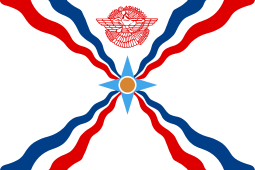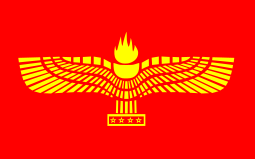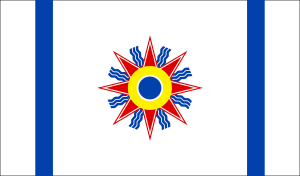Tur Abdin
Tur Abdin (Syriac: ܛܘܼܪ ܥܒ݂ܕܝܼܢ, romanized: Ṭur ʿAbdin;[1] Arabic: طَوْرُ عبدين) is a hilly region situated in southeast Turkey, including the eastern half of the Mardin Province, and Şırnak Province west of the Tigris, on the border with Syria. The name 'Tur Abdin' is derived from Syriac, meaning "mountain of the servants (of God)". Tur Abdin is of great importance to the Syriac Orthodox, for whom the region used to be a monastic and cultural heartland.[2] The Assyrian community of Tur Abdin call themselves Suryoye, and traditionally speak a central Neo-Aramaic dialect called Turoyo.[3][4]

| Part of a series on |
| Oriental Orthodoxy |
|---|
 |
| Oriental Orthodox churches |
|
Subdivisions
|
|
History and theology
|
|
Major figures
|
|
|
Geography
Settlements
The town of Midyat and the villages of Hah, Bequsyone, Dayro da-Slibo, Salah (with the old monastery of Mor Yaqub), Iwardo (with Mor Huschabo), Anhel, Kafro, Arkah (Harabale, with Dayro Mor Malke), Beth Sbirino, Miden (Middo), Kerburan, Binkelbe with Mor Samun Zayte and Beth Zabday (Azech) were all important Syriac Orthodox settlements among with countless other villages. Hah has the ancient 'Idto d'Yoldath-Aloho, the Church of the Mother of God.
History
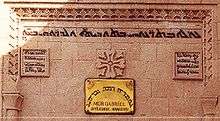
Antiquity
In the 9th century BCE the Assyrian King Ashurnasirpal II described crossing the plateau of Tur Abdin (which he calls "Kashyari") on his way to attack the region of Nairi. Assyrian source from the 9th century BC; where it is called "Kashyari".[5] In 586 B.C. the prophet Ezekiel mentions the famed wine of Izlo, on the southern edge of the plateau of Tur Abdin, in his prophecy against Tyre. The Mor Gabriel Monastery, the oldest Assyrian (Syrian Orthodox) church in the world, was founded in 397 by the ascetic Mor Shmu'el (Samuel) and his student Mor Shem'un (Simon). According to tradition, Shem'un had a dream in which an Angel commanded him to build a House of Prayer in a location marked with three large stone blocks. When Shem'un awoke, he took his teacher to the place and found the stone the angel had placed. At this spot Mor Gabriel Monastery was built.[6]
Modern
During World War I, 300,000 Assyrian Christians were killed in the Ottoman Empire's Assyrian Genocide (in Syriac, Sayfo, or 'the sword'). In the last few decades, caught between Turkish assimilation policies against Kurds, and Kurdish resistance, many Syriacs have fled the region or been killed. Today there are only 5,000, a quarter of the Christian population thirty years ago. Most have fled to Syria (where the city of Qamishli was built by them), Europe (particularly Sweden, Germany, the United Kingdom and the Netherlands), Australia and the United States. In the past few years, a few families have returned to Tur Abdin.[7]
Assyrian resistance in Tur Abdin during WW1
Prior to the start of World War I, the village of Gülgöze had about 200 families, and all were ethnic Assyrians that belonged to the Syriac Orthodox Church. During the Assyrian Genocide, tens of thousands of refugees from throughout Tur Abdin arrived here for safety. At one point, the number of Assyrians in the village was up to 21,980 people. Refugees arrived from villages including Habasnos, Midyat, Bote, Keferze, Kafro Eloyto, Mzizah and Urnas. Even refugees from outside Tur Abdin arrived, coming from villages such as Deqlath, Bscheriye, Gozarto, Hesno d Kifo and Mifarqin.
Being aware of the Turks and Kurds coming to Gülgöze, the Assyrian villagers and refugees created a militia to defend themselves, which was led by Masud Mirza, the son of a Melik. Their resistance lasted 60 days, and ended in success.[8]
At the same time, the Kurdish authority of Midyat was given orders to attack Gülgöze and Arnas. However, Aziz Agha, the leader of the Midyat area, told them that they didn't have enough soldiers to attack both areas, and therefore they would attack Gulgoze only, and then go to Arnas later on. Therefore, The Kurds of Tur Abdin and Ramman, under the generalship of Ahmed Agha and Salem Agha, collected themselves in Mardin, and created a unit of 13,000 men. The government authorized the distribution of arms, and they headed towards Gülgöze, arriving late at night to begin the siege.
After hours of gun-battle, the Assyrians defeated the Kurds and drove them out, but there were many casualties on both sides regardless. After 10 days, The Kurds attacked again only to be beaten yet again, as they lost well over 300 men. Before the beginning of a third attempt, Kurdish leaders called for aid from the mayors of Diyarbakır(Raschid) and Mardin(Badri). However, A third attempt also failed and after 30 days of battle, Aziz Agha suggested a peace treaty between the two sides. 3 Assyrians met with Aziz to discuss a peace treaty, But the Assyrians refused to lay down their weapons, thus the battle continued. The siege continued for another 30 days leading to many deaths on both sides. In the end, the Kurdish soldiers surrendered and left the Assyrians of Tur Abdin alone, hence why the Tur Abdin region is one of the only Christian populated areas left in Turkey outside of Istanbul. The total death toll of this 60-day siege is unknown, but there were at least 1,000 deaths with both sides losses combined.
Recent conflicts
On 10 February 2006 and the following day, large demonstrations took place in the city of Midyat in Tur Abdin. Muslims angry about the Jyllands-Posten Muhammad cartoons gathered in Estel, the new part of the city, and started to march towards the old part of Midyat (6 kilometers away), where the Christians live. The mob was stopped by the police before reaching old Midyat.
In 2008 a series of legal challenges were made against the monastery of Mor Gabriel. Some local Kurdish villages sought to claim land on which the monastery had paid taxes since the 1930s as belonging to the villages, and made other accusations against the monastery. This led to considerable diplomatic and human rights action throughout Europe and within Turkey.[9]
Monasteries
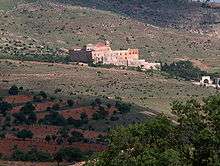
The most important Syriac Orthodox centre in Tur Abdin is the monastery of Dayro d-Mor Hananyo, 6 km south east of Mardin, in the west of the region. Built from yellow rock, the monastery is affectionately known as Dayro d Kurkmo in Syriac, Dayr al-Zafaran in Arabic, or Deyrülzafarân in Turkish: the Safron Monastery. Founded in AD 493, the monastery was the residence of the Syriac Orthodox Patriarch from 1160 to 1932. Although the patriarch now lives in Damascus the monastery still contains the patriarchal throne and tombs of seven patriarchs and metropolitans. Today the monastery is led by a bishop and a monk and some lay assistants, and is a school for orphans. The bishop of Mor Hananyo is also the patriarchal vicar of Mardin. His goal is to rebuild the monastery and to preserve the history of the Syriac Orthodox church. The Dayro d-Mor Hananyo is part of the UNESCO world cultural heritage and was visited by numerous celebrities e.g. like Prince Charles.
In the centre of the Tur Abdin region, a few miles south of Midyat, is Dayro d-Mor Gabriel. Built in AD 397, Mor Gabriel monastery, is the oldest functioning Syriac Orthodox monastery on earth. It is the residence of the Metropolitan Bishop of Tur Abdin, seven nuns, four monks and a host of guests, assistants and students. The monastery is charged with keeping the flame of Syriac Orthodox faith alive in Tur Abdin, for which it is as much a fortress as a church.[10]
The Saffron and Mor Gabriel monasteries are the most important of the region, existing along with six or seven other active monasteries:
- The Mor Augin Monastery, located on the southern slope of Mt. Izla, has only been recently revived. It has a historical significance to the region. As evidence of that, a Syriac Orthodox Bishop in the Netherlands took the name Augin in respect for the founder of the monastery.
- The Mor Abroham Monastery is located less than a mile east of Midyat, and it is known for having a large amount of farmland, some of which they donated to house Syrian refugees. Directly adjacent to the monastery lies the Turabdin Hotel and winery, which uses the monasteries vineyards to produce unique Assyrian wines endemic to the region.
- The St. Meryemana (Mary) Monastery, located next to the village of Antili, functions as the religious center for the remaining Christians of the village, and has a school for Assyrian children.
- The Mor Yakup (Jacob) Monastery is located next to the village of Baristepe, and, like the St Mary Monastery, functions as the religious center for the remaining Christians of the village.
- A second Mor Yakup Monastery is located in the village of Dibek (Syriac Badibe), having been rebuilt and occupied in 2013.[11]
- The Mor Malke Monastery is located on the northern slope of Mount Izla and is a few miles south of the village of Üçköy; it is connected by road to the village. Mor Malke is one of the newer monasteries of the region in terms of architecture, as it was rebuilt in the 30s. The monastery has a school, a church, and some farmlands.[12]
- One Monastery known as The Mor Aho Monastery was abandoned during the 1900s, but was later turned into a small walled village, when two dozen or so Assyrian villagers built houses in the courtyard of the Monastery because its high walls allowed for better security and defense than what their nearby village provided. The Monastery has one Nun, but as it has no monks or consistent liturgy held in its church it is technically not a monastery.[13]
Notable people
- Ibrahim Baylan (b. 1972), Swedish politician of Assyrian descent
- Shamoun Hanna Haydo (1870-1964), Assyrian leader in the early 20th century
- Nuri Kino, Swedish-Assyrian journalist
See also
| Wikimedia Commons has media related to Tur Abdin. |
- Mt. Izla
- Mardin
- Assyrians in Turkey
- Patriarchate of Tur Abdin
- Turoyo language
- Hakkari, another historical Assyrian region in Turkey
References
- Thomas A. Carlson et al., “Ṭur ʿAbdin — ܛܘܪܥܒܕܝܢ ” in The Syriac Gazetteer last modified December 9, 2016, http://syriaca.org/place/221.
- Aphram I. Barsoum; Ighnāṭyūs Afrām I (Patriarch of Antioch) (2008). The History of Tur Abdin. Gorgias Press. ISBN 978-1-59333-715-5.
- The Middle East, abstracts and index, Part 1. Library Information and Research Service. Northumberland Press, 2002. Page 491.
- Central Asia and the Caucasus: transnationalism and diaspora. Touraj Atabaki, Sanjyot Mehendale. Routledge, 2005. Page 228.
- From Kibaki I set out and approached Matiate (Midyat). Matiate and its villages I overcame . . . For six days in the midst of the mighty mountain of Kashyari (Tur Abdin) - a difficult country . . . I worked that mountain with iron axes . . . Then I caused my chariots . . . to pass over it . . . I passed mount Kashyari and came a second time to the lands of Nairi.
- Tur Abdin Timeline Archived 2015-04-19 at the Wayback Machine
- "Assyrians who fled to Europe return to homes in Turkey's Mardin".
- Gaunt, David; Bet̲-Şawoce, Jan (1 January 2006). Massacres, Resistance, Protectors: Muslim-Christian Relations in Eastern Anatolia During World War I. Gorgias Press LLC. p. 348. ISBN 978-1-59333-301-0.
- The Case of the St. Gabriel Syriac Monastery in Midyat, Turkey , 2010.
- Delcogliano, Mark. "Syriac Monasticism in Tur Abdin: A Present-Day Account". Cite journal requires
|journal=(help) - "Kirche unterwegs – Reiseblogs aus der Evangelischen Kirche von Westfalen".
- http://souf.nu/tur-abdin-resan-2014-dag-9-10. Missing or empty
|title=(help) - https://www.aina.org/ata/2013101916954.htm. Missing or empty
|title=(help)
External links
- Comfort, Anthony (2017). "Fortresses of the Tur Abdin and the confrontation between Rome and Persia". Anatolian Studies. 67: 181–229. doi:10.1017/S0066154617000047.
- The Diocese of Linz Eastern Christian Initiative and the Friends of Tur Abdin (in German)
- Maps of Tur Abdin
- Webmagazine Shlama
- Margonitho - Syriac Orthodox Resources (see Churches & Monasteries, History and the Rev Stephen Griffith Reports from Tur Abdin)
